Municipal elections - what kind of candidates?
Majority men and representatives of large age groups
A total of 39,744 candidates were nominated for the Municipal elections, which is 3,360 less than in 1996. Of the candidates, 15,200, or 38 per cent, are women. The proportion of women has grown by two percentage points. The largest number of candidates were nominated by the Centre Party (11,355), the Social Democratic Party (8,875), the Coalition Party (7,356) and the Left Alliance (4,478). The Green League, the Swedish People's Party of Finland and the Christian League have over 1,500 candidates each, True Finns 737 candidates and the Communist Party of Finland 292. For reasons of data protection, the candidates of small parties are not examined separately.
The majority of persons entitled to vote are women, i.e. 51.8 per cent, while the figure of female candidates is 38.2 per cent. Only the Green League has women as a majority among its candidates (50.7%), the next closest to being equal is the Christian League, where the proportion of women is 46.9 per cent. In the Coalition Party, the Centre Party and the Social Democratic Party the proportion of women is slightly under 40 per cent. The number of female candidates is highest in the region of Uusimaa, 40.5 per cent and lowest in Lapland, 35.7 per cent.
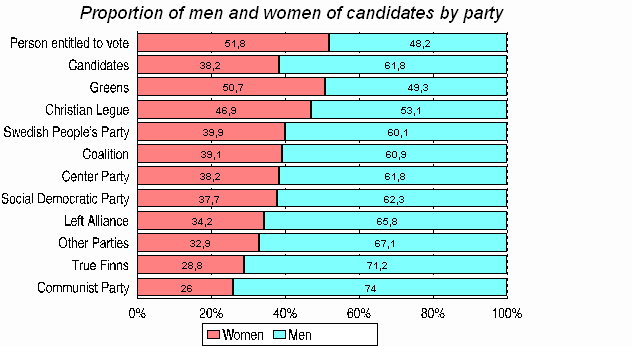
The average age of persons entitled to vote is 47.4 years and the average age of candidates 45.9. Female candidates are 4.6 years younger than female voters, on average, while male candidates are 1.2 older than male voters. The number of male candidates is largest in the age group of 50-59 year-olds, and that of female candidates in the group of 40-49 year-olds. The representatives of large age groups among the candidates clearly exceed their proportion of the whole population, while the number of candidates in over 70-year-old and under 40-year-old age groups is lower than their proportion of the total population.
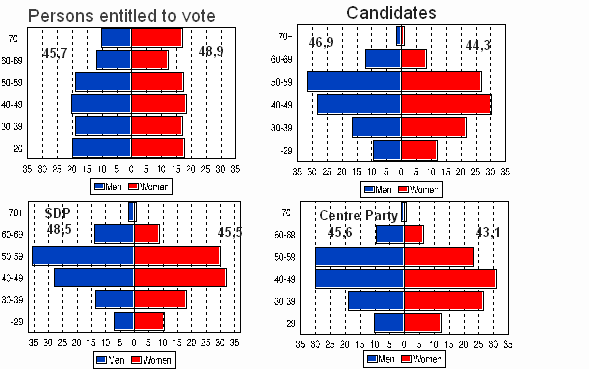
The differences by party are fairly small: the average age of female candidates is 2 to 3 years lower than that of men, with the exception of the Greens. The Social Democrat and Christian League candidates have the highest average age, for men it mainly centres on the age group of 50-59 and for women on the ages of 40-49.
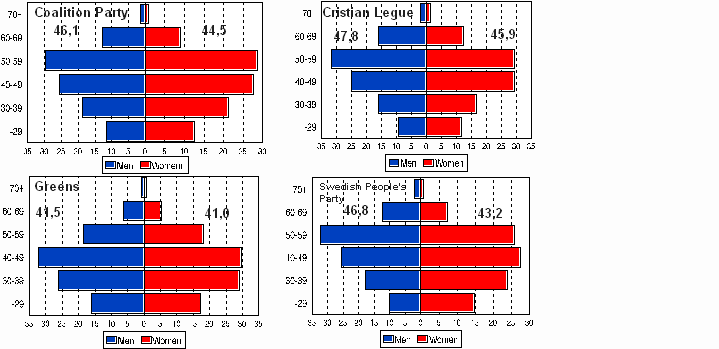
The Coalition Party and the Swedish People's Party have slightly younger candidates. The Greens' candidates are the youngest: the average age for men is 41.5 and for women 41.0. The Centre Party also has somewhat younger candidates than the Coalition Party and the Social Democratic Party. Age differences by region vary according to party: the Social Democratic Party has the oldest candidates in Lapland and the youngest in Satakunta, and the youngest candidates of the Centre Party live in Itä-Uusimaa. The oldest Green candidates are found in South Karelia and the youngest in Central Ostrobothnia, the age difference for men being 11.7 and for women 13.1 years. The Greens have relatively the highest number of candidates aged 30-39 and 20-29 and the lowest of candidates aged 60 or over.
Educational level of candidates high
The candidates differ clearly by their education from all persons entitled to vote. 76 per cent have attained a higher educational level than basic level, while 59.4 per cent of all persons entitled to vote have some post basic level education. The Coalition Party, the Swedish People's Party, the Greens and the Christian League have the highest number of highly educated candidates. The Social Democratic Party differs from these in that it has fewer candidates with tertiary education, in particular, i.e. 27.5 per cent. The Coalition Party has twice as many candidates with tertiary education, that is, 57.9 per cent. The Green League has the highest number of candidates with academic degrees, or 26.9 per cent. In the Municipal elections, the educational level of the candidates reflects the differences in the educational structure in the area. In all major parties, the best educated candidates live in Uusimaa, the least educated are, with some variation, from Eastern or Central Finland. The proportion of the highly educated is usually double in Uusimaa compared to the least educated areas.
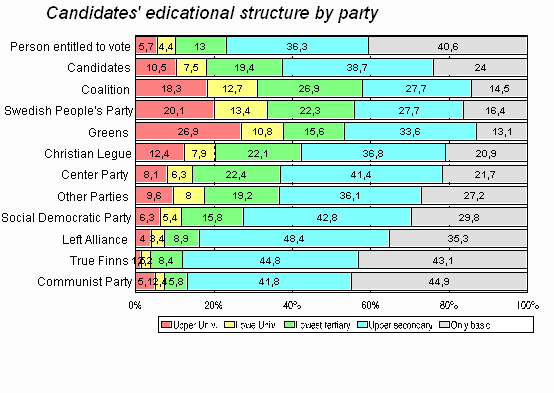
Family situation in order
While only one third of all persons entitled to vote live together in the same household with his/her married spouse and children, the majority of the candidates, or 52.2 per cent, live in a family of that kind. In addition, 17.9 per cent live together with just their spouse. Ten per cent are cohabiting; six per cent are female single parents and two per cent male single parents. Thirteen per cent are singles or not belonging to families.
Although the average age of the candidates is close to 50, surprisingly many still have children living at home. 63 per cent of the Centre Party, 60 per cent of the Christian League, 57 per cent of the Swedish People's Party, 55 per cent of the Coalition Party and 45 per cent of the Social Democrat candidates are married and living together with their spouse and children. Cohabiting was the most common for the candidates of the Green League, the Left Alliance and the Communist Party, of whom about 15 per cent cohabited. The number of pensioners not belonging to families was highest among the Communist Party candidates.
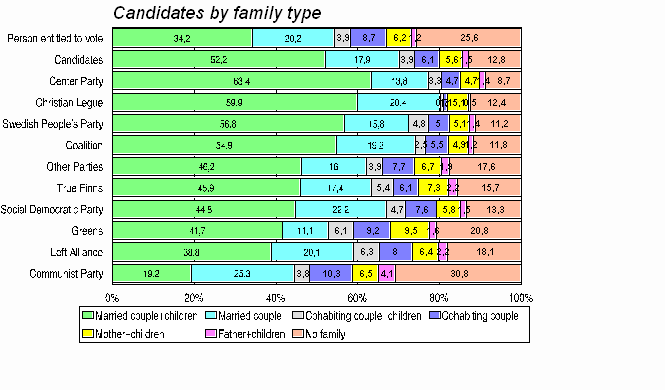
Family type does not reveal how many of the candidates have had children of their own, because in older families, in case of divorce, etc. children can live apart from the candidates. The number of biological children tells how many candidates have experience of their own children. Of all persons entitled to vote, 35 per cent do not have children of their own, while this is the case for 19.7 per cent of the candidates. The number of childless candidates varies from 16.9 per cent for SDP to 32.5 per cent for the Greens. The Greens have several young candidates, who may not have had children yet. Large families are the most numerous for the True Finns and Christian League candidates, of whom ten per cent have at least five children. The family size is also larger for the Centre Party candidates than for the
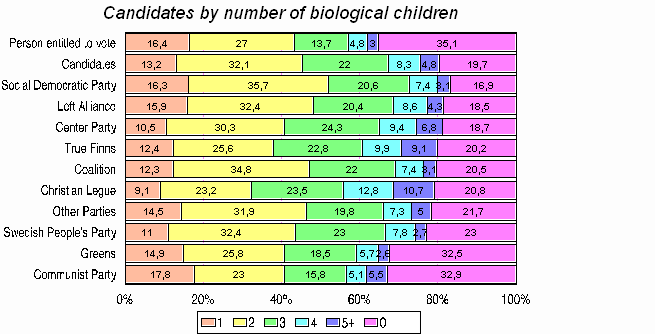
candidates of the Social Democratic Party and the Coalition Party. The candidates' number of children reflects the birth rate in the area, which means that the number of large families is highest in Ostrobothnia and lowest in Uusimaa.
Employment problems rare
Of those entitled to vote, one half are employed (52.3%), 10 per cent are unemployed, a quarter are retired and 13 per cent are students or do household work. Of the candidates, clearly more, 75 per cent, are employed, a slightly fewer are unemployed and clearly fewer, or just nine per cent, are pensioners. The number of employed persons is highest among the candidates of the Swedish People's Party, the Centre Party and the Coalition Party and unemployment is less common than average for them. The candidates of the Social Democratic Party, the Greens, the Christian League and the Left Alliance have been affected by unemployment as often as persons entitled to vote. The Greens have relatively the largest number of student candidates (11.9%). The proportion of pensioners is largest in the Communist Party, but high in other small parties as well, of which some are specifically pensioners' parties.
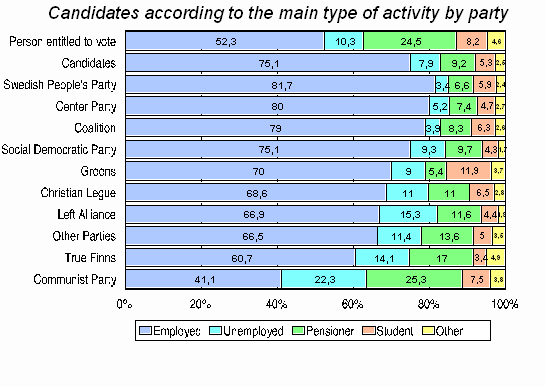
In the region of Uusimaa the candidates differ the least from their voters in their employment rate, the difference being just 15 percentage points. The difference between the candidates and voters is largest in South Karelia and Pohjois-Savo, where the difference in the employment rate is about 45 percentage points. The candidates' employment rate is even better there than in Uusimaa.
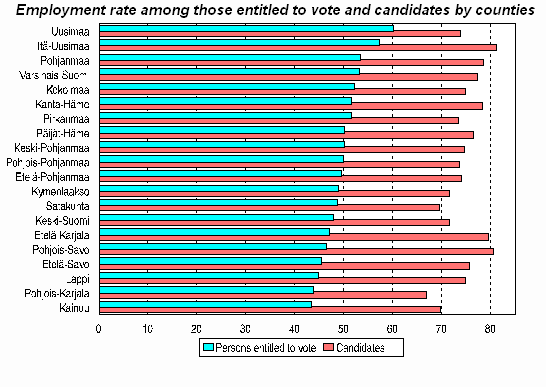
Income higher than that of voters
The candidates are better educated and more often employed than voters in the area concerned. This partly explains why their average taxable income is generally much higher than that of persons entitled to vote. The average income of persons entitled to vote was FIM 103,000, while it was FIM 136,000 for the candidates in the 1998 taxation.
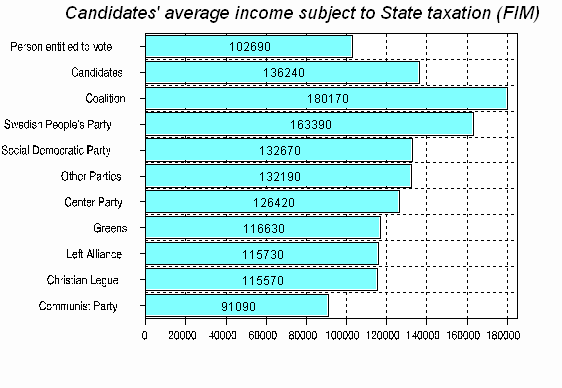 Income varied by party from FIM 180,000 of the
Coalition Party to FIM 91,000 of the Communist Party. The average
income of the Centre Party and SDP candidates was FIM 50,000 lower
than that of the Coalition Party candidates. The Greens' younger
and often student candidates gained only slightly higher average
income than persons entitled to vote.
Income varied by party from FIM 180,000 of the
Coalition Party to FIM 91,000 of the Communist Party. The average
income of the Centre Party and SDP candidates was FIM 50,000 lower
than that of the Coalition Party candidates. The Greens' younger
and often student candidates gained only slightly higher average
income than persons entitled to vote.
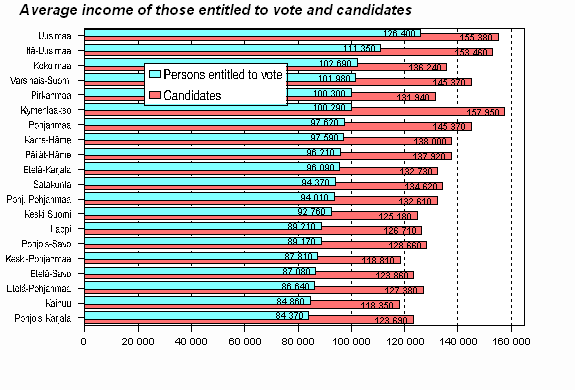
The average incomes of the candidates and voters are closest to one another in Uusimaa, where the difference is just 23 per cent and the farthest apart in Kymenlaakso, where the average income of the candidates is 58 per cent higher than that of the voters in the region. In Ostrobothnia the difference is also nearly 50 per cent. In other regions the difference varies between 30 and 45 per cent.
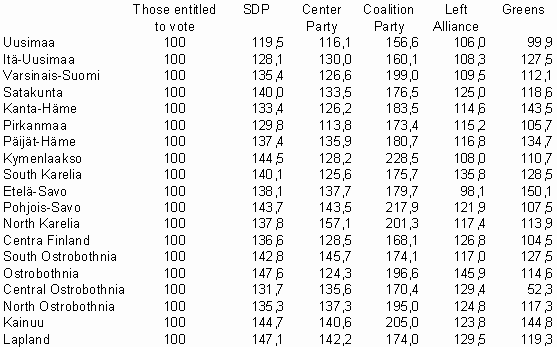
The Coalition Party candidates differ most from the voters in their area: the difference is largest in Kymenlaakso, where the average income of the candidates is 2.3-fold compared to voters. At its lowest the difference is in Uusimaa, at 57 per cent. The Social Democratic Party differs the most clearly from voters in Lapland, with a difference of 47 per cent and the least in Uusimaa with 20 per cent. The Centre Party candidates have the largest difference in North Karelia, i.e. 57 per cent and the smallest in Uusimaa, 16 per cent. The annual income of the Left Alliance and Green candidates also exceeds at its best the income of voters by 35 to 50 per cent. In some regions the income of the candidates is even lower than average for the region. This is the case for the Left Alliance in Etelä-Savo and for the Greens in Central Ostrobothnia and Uusimaa.
Last updated 31 May 2004
Official Statistics of Finland (OSF):
Municipal elections [e-publication].
ISSN=2323-1114. 2000,
Municipal elections - what kind of candidates?
. Helsinki: Statistics Finland [referred: 3.12.2025].
Access method: http://stat.fi/til/kvaa/2000/kvaa_2000_2004-05-31_kat_002_en.html

